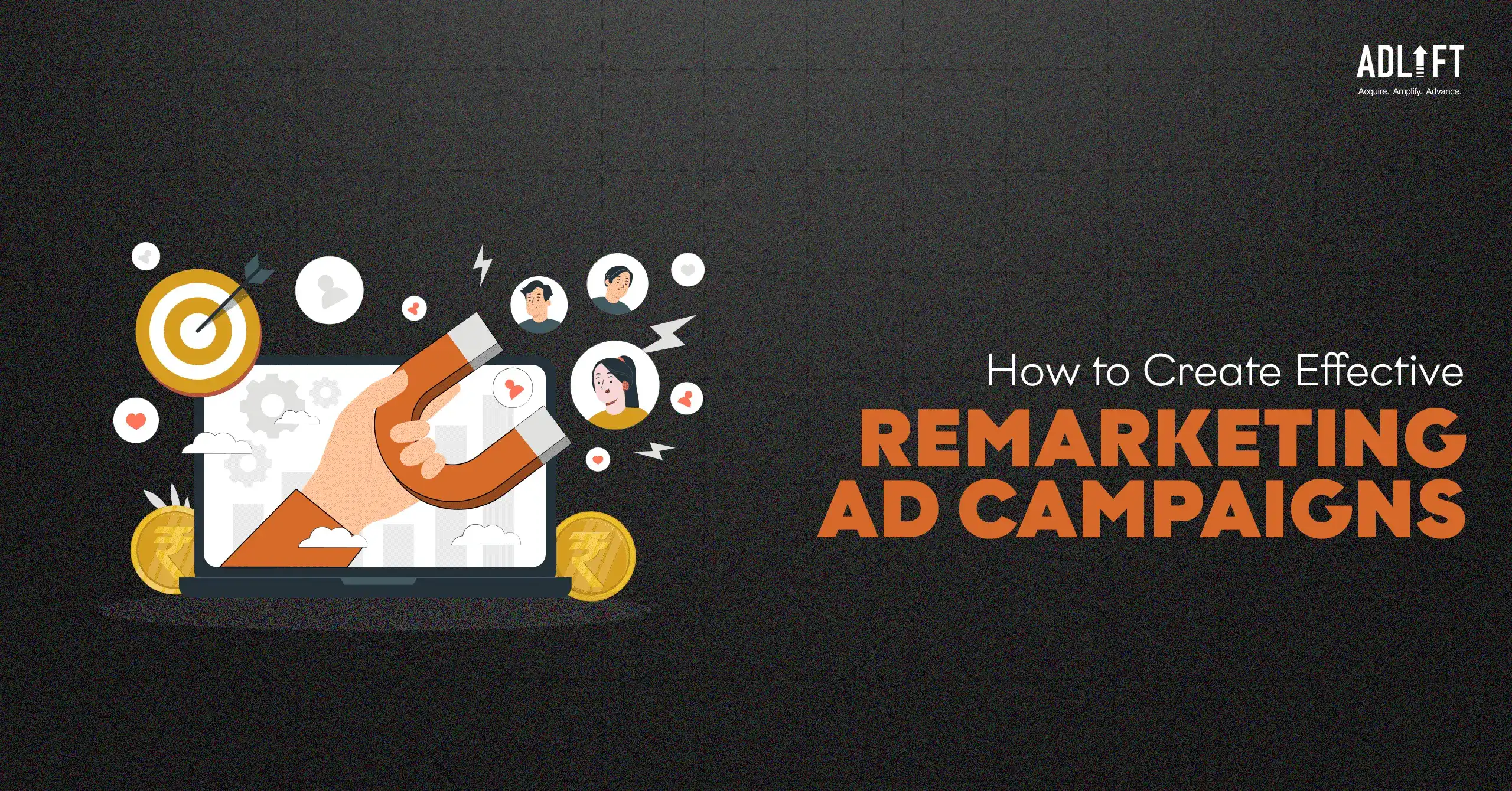How to Create Effective Remarketing Ad Campaigns?

Do you know that 70.19% of people abandon their shopping carts before making a purchase? This happens because every consumer is at a different stage of their buying journey. And, with the emergence of too many niche brands, consumers will take time to analyze the products before making the final purchasing decision.
In this case, you want your brand to be on top of the shopper’s minds. But that becomes a difficult task amid all the digital noise brands make. However, the beauty of online shopping remains in the fact consumers employ various platforms and websites at once. This presents a unique opportunity for digital marketers, i.e., Remarketing Ad campaigns.
What are Remarketing Advertisements?
Remarketing, also known as retargeting, allows businesses to reengage with potential consumers who have previously visited the website or app. As they browse through other websites and applications, they will see your brand’s ads. These remarketing ad campaigns will effectively make a way through the digital clutter and ensure that your brand remains in the minds of the consumers, leading to higher conversion rates and fostering brand loyalty.
Remarketing advertisements work on a predefined criterion your business has set to identify interested users and visitors. Cookies implement the tracking process and collect the visitor’s data and behavior. Brands analyze all this information to showcase relevant advertisements for better consumer satisfaction and conversion rates.
How can Remarketing Ads impact your business?
A strategically designed remarketing ad campaign is a crucial element in digital marketing. Let’s discuss the key impacts of remarketing ads on your business:
Be at the Forefront of Consumer’s Minds
With the amount of digital content people interact with daily, it’s easier to forget about a brand they visited once. However, remarketing keeps your brand in front of potential customers. This constant exposure reinforces brand recognition and recall, making it more likely for users to return to the website when they are ready to make a purchase.
Quality Leads and Traffic
As your targeted users are already familiar with your brand, the click-through rates in these campaigns are always much higher. Even research and data consistently show that remarketing ads can achieve CTRs that are 2-3 times higher than standard display ads.
This high engagement rate reflects the effectiveness of reaching out to users ready for further interaction.
Personalized Advertising
Customized and tailored advertisements are created based on the consumer’s behavior and shopping history. The retargeting display ads show relevant products and services to your potential buyers.
Additionally, showcasing the new products to previous consumers increases the chances of a one-time buyer becoming loyal. This pushes the shoppers to make a purchasing decision while making them feel seen and valued.
Improved Conversion Rates
98% of your website traffic won’t convert on the first visit. This leaves you with the remaining 2%, meaning you must add more value for your visitors.
A few elements can make or break a remarketing advertising campaign. These include relevancy and selectiveness in terms of showing the right advertisement to the right people.
Upsell and cross-sell
Based on past purchases, remarketing showcases complementary products or more valuable items to shoppers. This increases the order value of your product while also positively impacting your ROI.
Want to Get Started on your Remarketing journey?
Types of Remarketing Ads
When it comes to remarketing ads, there are endless ways you can retarget the users, such as:
Standard/Display Ads
This advertising employs paid ads. A display ad is exhibited on third-party websites to reach the pre-engaged audience. Marketers use remarketing Google Ads to enhance the brand’s reach. Additionally, display ads appear on networks connected to the ad network you have opted for.

Dynamic Remarketing Ads
Considered one of the most unique ads, dynamic ads come in various forms. They are displayed uniquely for every user and include specific products or services that these consumers have previously viewed or interacted with on your website.
Many people may not be receptive to generic ads, but they are more likely to interact with ads that interest them.
Search Ads
Similar to display ads, search remarketing also employs paid advertising. However, instead of displaying the ad on the third-party website, search remarketing displays the ads on search engine results pages.

Video Remarketing Advertisements
As the name suggests, video remarketing uses video content. YouTube is the prime platform for video remarketing.

Email Remarketing
This remarketing ad form does not require paid advertising. Instead, you can send promotional and reminder emails to those who have subscribed to the brand’s mailing list.

Social Media Remarketing Ads
LinkedIn, Instagram and Facebook remarketing are the most popular forms of social media remarketing. They appear in the feed of those users who have visited your social media platform.

Getting Started with a Remarketing Ad Campaign
Define your Audience and Goals:
The first step in remarketing is to define the specific goals that you want to reach. Do you want more website traffic, conversions, or brand awareness? All the goals work on different metrics. Then, specify the audience to whom you want to remarket and segment them depending on the section of the website they have visited. This process can be implemented through various remarketing tools such as Google Ads Remarketing and Microsoft Advertising Customer Audience Targeting.
Set the Duration
There’s a set duration for showcasing yours to the users. If you set up an ad for 30 days, then the people who have interacted with your business will only see your ads for that duration.
Compelling Ad Copies
The success of your day marketing advertisement heavily relies on the quality of your ad copies. To ensure the ad copy generates a desired response, prioritize choosing the right format and platform. Employ the right visuals, set the tone, and create a copy that emotionally resonates with your target audience.
Check and Optimize
Continuous monitoring and optimizations play a significant role in the success of your remarketing ad. So, measure the click-through and conversion rates and calculate the cost of spending and acquiring to understand the efficiency of your remarketing ad. To understand this better, let’s take an example. Suppose you invest $50, but the conversions you are getting are worth only $40. Your ad campaign may need to perform better and vice versa.
Strategize the Bid Management
Now, it’s time to get hold of PPC marketing. In this marketing, you have to pay for each click. The advertiser chooses the maximum per-click cost that they are willing to pay. Additionally, you can select the exact buyer persona, like age, demographics, gender, etc., to maximize the effectiveness of your remarketing ads.
Latest Trends in Remarketing Ads
Remarketing ads are continuously evolving due to the latest advancements and innovations that are integrated into advertisements.
Dynamic Creative Optimization
DCO, or dynamic creative optimization, allows advertisers to personalize and customize advertisements according to their target audiences. DCO also aids businesses in optimizing the advertisement’s format, layout, and copy to increase engagement and conversions.
Cross-device and Channel Remarketing
This channel prioritizes maintaining a constant strategy across various channels (social media, email, search ads) and devices (mobile, tablet, desktop). For instance, even if a user starts looking for flights on Google through their laptop, they will view advertisements related to flight bookings even on their smartphones and social media channels.
AI and ML Integration
Artificial intelligence has become the talk of the century, and its integration into ad campaigns has enhanced the user experience. AI predicts the consumer’s behavior, increasing the likelihood of conversion, while machine learning optimizes bidding, ad placement, and targeting criteria automatically. Hence, it saves time and improves performance.
For instance, Netflix taps into AI’s potential to recommend new shows and movies based on viewers’ history. When users leave the platform, they see personalized ads suggesting new releases or content similar to what they’ve previously watched.
Privacy Policies
In pursuit of securing privacy and data, cautious consumers demand more transparency and control over their online experience. This led to the emergence of various privacy regulations, such as the U.S. Privacy Act of 1974, which have significantly impacted remarketing ads.
Now, companies are required to obtain users’ consent and be more transparent about how they track users across the web and utilize their data for remarketing purposes. However, by integrating this approach, businesses not only comply with the legal requirements but also enhance users’ trust and loyalty.
Omnichannel Retargeting
One of the emerging trends in retargeting is the omnichannel approach that focuses on supplying a more holistic customer experience through all touch points and channels. This approach acknowledges that modern consumers interact with brands in numerous ways, such as browsing websites, engaging on social media, and visiting physical stores.
In omnichannel retargeting, marketers track these interactions across different devices and platforms to create an invariant consumer profile. This allows the brands to deliver consistent and relevant messages to users regardless of their demographics.
Choose AdLift as the Remarketing Partner.
Testing the Effectiveness of Your Remarketing Ads
By testing and analyzing the effectiveness of your remarketing, you can easily comprehend where your advertisement campaign stands and what changes can positively impact your consumers. A/B testing is a useful way to test remarketing advertising since it compares two versions of an advertisement to decide which one performs better. This can include changes in the ad language, visuals, and CTA. Changing one aspect at a time and studying the outcomes will help you identify what resonates better with your target audience.
Another method to analyze the remarketing campaign is the customer retention rate (CRR), which indicates the percentage of consumers who make a repeat purchase within a given time period. The higher the CRR, the better the retained consumer rate. When combined with efficient remarketing methods, these testing tools form a comprehensive approach to customer retention that can result in long-term success.
Make the Right Remarketing Ads Strategies with AdLift!
Remarketing ad campaigns generate quality leads and traffic by leveraging the familiarity and interest of targeted users. Additionally, the higher click-through rates in remarketing campaigns testify to their effectiveness in engaging users already in the consideration phase of their buyer’s journey. AdLift’s remarketing strategies and solutions can significantly improve your ROI. We employ strategic remarketing techniques that ensure your ads are seen by the right audience at the right time. Our team of experts continuously analyzes user behavior and preferences to craft personalized ads that resonate with your target audience.
When AdLift manages your remarketing campaigns, you can focus on your business while our experts optimize your conversion rates. Our data-driven approach ensures that every remarketing ad is tailored to maximize impact. Hence creating the best retargeting ad.
Categories
Recent Posts
- How do I Verify My Business on Google to Ace Local SEO? March 17, 2025
- The Pros and Cons of Pay For Performance SEO March 17, 2025
- Website Structure for SEO: A Blueprint for Better Rankings March 17, 2025
- Is SEO for Subdomains Hurting your Rankings? Let’s Find Out! March 17, 2025
- Outsourcing SEO: A Cost-effective Solution for Startups to Scale Quickly March 17, 2025
- Keyword Cannibalization: Why It Matters for Your Company and How to Avoid It March 12, 2025
- The Role of SEO Projections in Budget Planning for CMOs March 11, 2025
- SEO for Bing: Unlocking Opportunities for Business Owners and Marketers March 11, 2025
- How to Maintain SEO and Rankings: Your SEO Maintenance Checklist March 7, 2025
- Must-have Enterprise SEO Tools to Boost your Online Presence March 7, 2025
Get
in Touch
Contact AdLift for a 360-degree marketing plan





